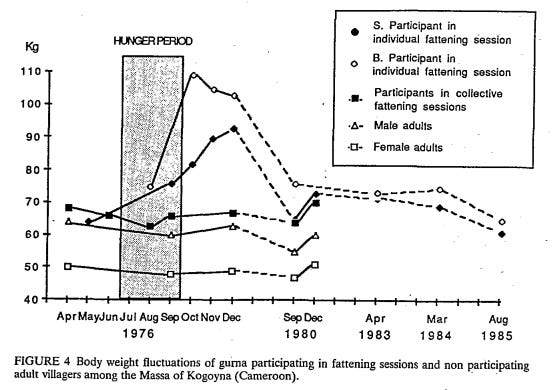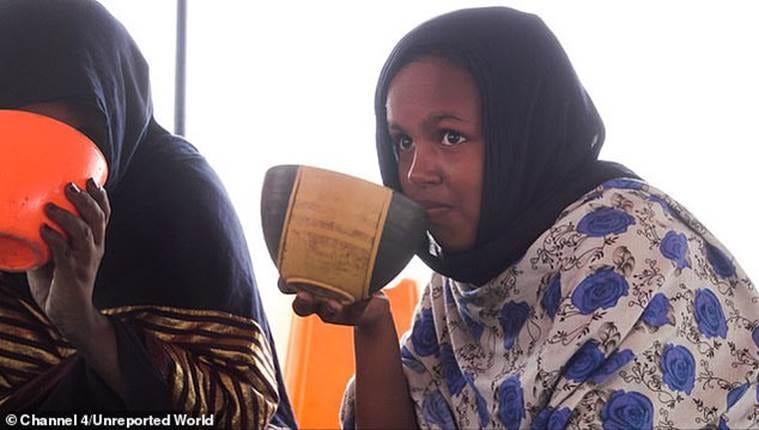The Fat-Farms of Mauritania
- Get link
- X
- Other Apps
The Fat-Farms of Mauritania
Force-feeding girls for marriage
January is the month of the diet. New Year’s resolutions abound to cut down on snacks, to go to the gym, to lose weight. Extra fat is now not just for Christmas though, it is a global problem - but what would the opposite of a weight-loss camp look like? A place to deliberately become obese? Do such places exist?
On one end of the spectrum we could look at the Japanese sumo wrestling tradition, where practitioners become fat in order to leverage their bulk against their opponent. A method of metabolic hacking is used, where wrestlers skip breakfast and eat a massive 10,000 calorie lunch of chankonabe stew, followed by a nap. The combination of calorie loading, large amounts of beer and short feeding windows causes rapid weight gain.
Another variant found across the world is the ‘fattening room’ ritual. This typically involves young women, and sometimes men, being secluded from the community and fed large amounts of obesogenic foods, as well as other beautification practices. The emphasis seems to be on becoming bigger, more voluptuous, more energised and sexy. Prior to access to modern food, many Pacific Polynesian islands had a fattening room practice. Curiously the two modifications most prized during seclusion were weight gain and skin lightening, as described here by Nancy Pollock (1995):
Nineteenth century European visitors described Nauruan people as powerful and well-nourished, with bodies that were “inclined to be a little plump’” one woman’s weight “increased to 400 pounds”, and several women bearing names meaning fat or plump, “thin or bony people were the exception”. Another writer described the women “in their middle years as perambulating lumps of fat”.
Such enlarged bodies together with lightened skin were considered hallmarks of beauty in which the whole community took pride.
Both Tahiti and Nauru made use of breadfruit, bananas, coconuts and fatty fish to build up weight in their fattening rooms. Excessive amounts of breadfruit were considered to make the skin more pale while in seclusion.
Similar fattening rooms or institutions are found in Nigeria and the surrounding regions, including amongst the Igbo, Ekoi, Efik, Ibibio and Anaang peoples. In Cameroon the Massa people perform one of the strangest such rites, where the men attempt to get as fat as possible within a two-month window:
The Massa, who consider themselves herders and fishermen, are reluctant farmers. This adds to the environmental constraints they endure with the result that, on average, they cultivate a small acreage (0.4 hectares per adult) of food crops, too little to satisfy their needs. Their only access to cash is through the irregular income derived from cotton growing and fishing. Having to fulfil the requirements of a costly bridewealth system, they do not devote systematically their income to buying the missing food stores, with the result that they constantly face a seasonal pre-harvest cereal shortage. The restricted dietary period usually lasts about one month, resulting in an average weight loss of about 2 kg. In bad years, such as 1980 and 1985, it can reach 7 kg, and is experienced as a dramatic period of hunger. Famines have often occurred in the area. Until the beginning of the century they resulted in children being sold to better-off Fulani neighbours. Oral literature reflects food anxiety, and eating abundantly remains a concern in daily life.
-Guru-Fattening Sessions Among The Massa (1990) Igor de Garine & Georgius Koppert
In order to demonstrate their skill at coaxing excess food from their lands, men will undergo a grueling period of weight gain in the second part of the rainy season, between August and October - the guru.
The descriptions of the practice make for stomach-churning reading, but in general it involves a two-week gorging period where the men attempt to consume 10,000 calories a day of milk, sorghum porridge and sorghum bread a day. Forcing this volume of material into one’s body has unpleasant consequences, and the men have to sit upright for many hours, lest they be required to eat their own vomit. The gains are impressive, up to a 45% increase from their initial bodyweight. The men may be unable to move, or have to use crutches to heave their swollen bellies around.
Many of these fattening rooms institutions are vanishing however, under the pressure of modernity. Convenience foods, medical interventions and campaigns, changing body image standards and access to food all year around have impacted on the desirability of being overweight. However, one country stands out - Mauritania and the pre-marital rite of leblouh.
The Fat Farms of Mauritania
In 2008 the military junta of Mauritania announced a ‘return to tradition’, slashing ministerial oversight of women’s issues and pushing for old-fashioned values to be upheld and reinstated. In Mauritania, where the historical division between nomadic white-skinned Berber-Arabs and black African slaves still matters, this meant celebrating the image of the aristocratic Arab woman, sat chubbily in her tent, watching her servants toil in the sun.
The necessity of being overweight before marriage has been so historically intense in Mauritania that a practice known as leblouh or gavage is still widespread throughout the country. This involves taking young girls away from their families and force-feeding them vast quantities of milk, peanut oil, butter and couscous until they reach a sufficient level of obesity. Professional force-feeders, known as ‘fatteners’, oversee the process - themselves usually older women.
The food intake is staggering. Some descriptions speak of 14 - 16,000 calories per day, coming from a brutal combination of camel milk and buttery porridge. 20 liters of milk might be forced down a girl’s throat, some as young as six years old. Little wonder the French term gavage is used, the word for force-feeding foie gras geese.
"I make them eat lots of dates, lots and lots of couscous and other fattening food," Fatematou, a voluminous woman in her sixties who runs a kind of "fat farm" in the northern desert town of Atar, told BBC World Service's The World Today programme.
Although she had no clients when I met her, she said she was soon expecting to take charge of some seven-year-olds.
"I make them eat and eat and eat. And then drink lots and lots of water," she explained.
She said the girls could end up weighing between 60 to 100 kilograms, "with lots of layers of fat."
Fatematou said that it was rare for a girl to refuse to eat, and that if they did, she was helped by the child's parents.
"They punish the girls and in the end the girls eat," she said.
"If a girl refuses we start nicely, saying 'come on, come on' sweetly, until she agrees to eat."
Fatematou admitted that sometimes the girls cried at the treatment.
"Of course they cry - they scream," she said.
"We grab them and we force them to eat. If they cry a lot we leave them sometimes for a day or two and then we come back to start again.
"They get used to it in the end."
She argued that in the end the girls were grateful.
"When they are small they don't understand, but when they grow up they are fat and beautiful," she said.
"They are proud and show off their good size to make men dribble. Don't you think that's good?"
The prevalence of leblouh is unknown, but some studies estimate 20% of women have undergone some version of the practice. Others may resort to steroids or antihistamines to help gain weight, if the food is too expensive. The brutality of the ‘farms’ also seems to be increasing. Women have described the agony of distended stomachs, being beaten, having their toes crushed for refusing to eat, being forced to eat any regurgitated food, even rumours of animal growth hormones being slipped into the mix.
Of course, the long term consequences of rapid obesity are profound. Hypertension, diabetes, loss of mobility, joint damage and so on. Sadly for Mauritania’s women, leblouh is just one of many social ills they face - child marriage, polygamy, widespread FGM and high levels of illiteracy plague the country. Mauritania also has the world’s largest number of slaves, maybe between 2-5% of the population. Slavery was only legally abolished in the 1980’s, and generational slave status is commonplace. Some parts of the world really are dark places.
The light at the end of this particular tunnel comes in the form of pop music, contemporary French fashion and access to the internet. Male tastes are moving towards thinner women, hopefully prompting a shift away from the fat farms and to a focus on health.
Source: Grey Goose Chronicles
- Get link
- X
- Other Apps


Comments
Post a Comment